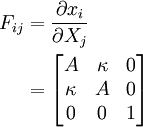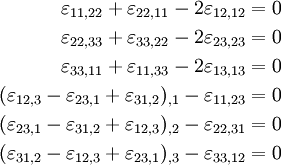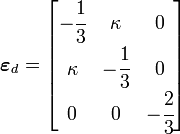Introduction to Elasticity/Sample midterm5
< Introduction to ElasticitySample Midterm Problem 5
Suppose that, under the action of external forces, a material point
 in a body is displaced to a new location
in a body is displaced to a new location
 where
where
and  and
and  are constants.
are constants.
Part (a)
A displacement field is called proper and admissible if the Jacobian ( ) is greater than zero. If a displacement field is proper and admissible, then the deformation of the body is continuous.
) is greater than zero. If a displacement field is proper and admissible, then the deformation of the body is continuous.
Indicate the restrictions that must be imposed upon  so that the deformation represented by the above displacement is continuous.
so that the deformation represented by the above displacement is continuous.
Solution
The deformation gradient  is given by
is given by
Therefore, the requirement is that  where
where
The restriction is
Part (b)
Suppose that  . Calculate the components of the infinitesimal strain tensor
. Calculate the components of the infinitesimal strain tensor  for the above displacement field.
for the above displacement field.
Solution
The displacement is given by  . Therefore,
. Therefore,
The infinitesimal strain tensor is given by
The gradient of  is given by
is given by
Therefore,
Part (c)
Calculate the components of the infinitesimal rotation tensor  for the above displacement field and find the rotation vector
for the above displacement field and find the rotation vector  .
.
Solution
The infinitesimal rotation tensor is given by
Therefore,
The rotation vector  is
is
Part (d)
Do the strains satisfy compatibility ?
Solution
The compatibility equations are
All the equations are trivially satisfied because there is no dependence on  ,
,  , and
, and  .
.
Part (e)
Calculate the dilatation and the deviatoric strains from the strain tensor.
Solution
The dilatation is given by
Therefore,
The deviatoric strain is given by
Hence,
Part (f)
What is the difference between tensorial shear strain and engineering shear strain (for infinitesimal strains)?
Solution
The tensorial shear strains are  ,
,  ,
,  .
The engineering shear strains are
.
The engineering shear strains are  ,
,  ,
,
 .
.
The engineering shear strains are twice the tensorial shear strains.
Part (g)
Briefly describe the process which you would use to calculate the principal stretches and their directions.
Solution
- Compute the deformation gradient (
 ).
). - Compute the right Cauchy-Green deformation tensor (
 ).
). - Calculate the eigenvalues and eigenvectors of
 .
. - The principal stretches are the square roots of the eigenvalues of
 .
. - The directions of the principal stretches are the eigenvectors of
 .
.
















